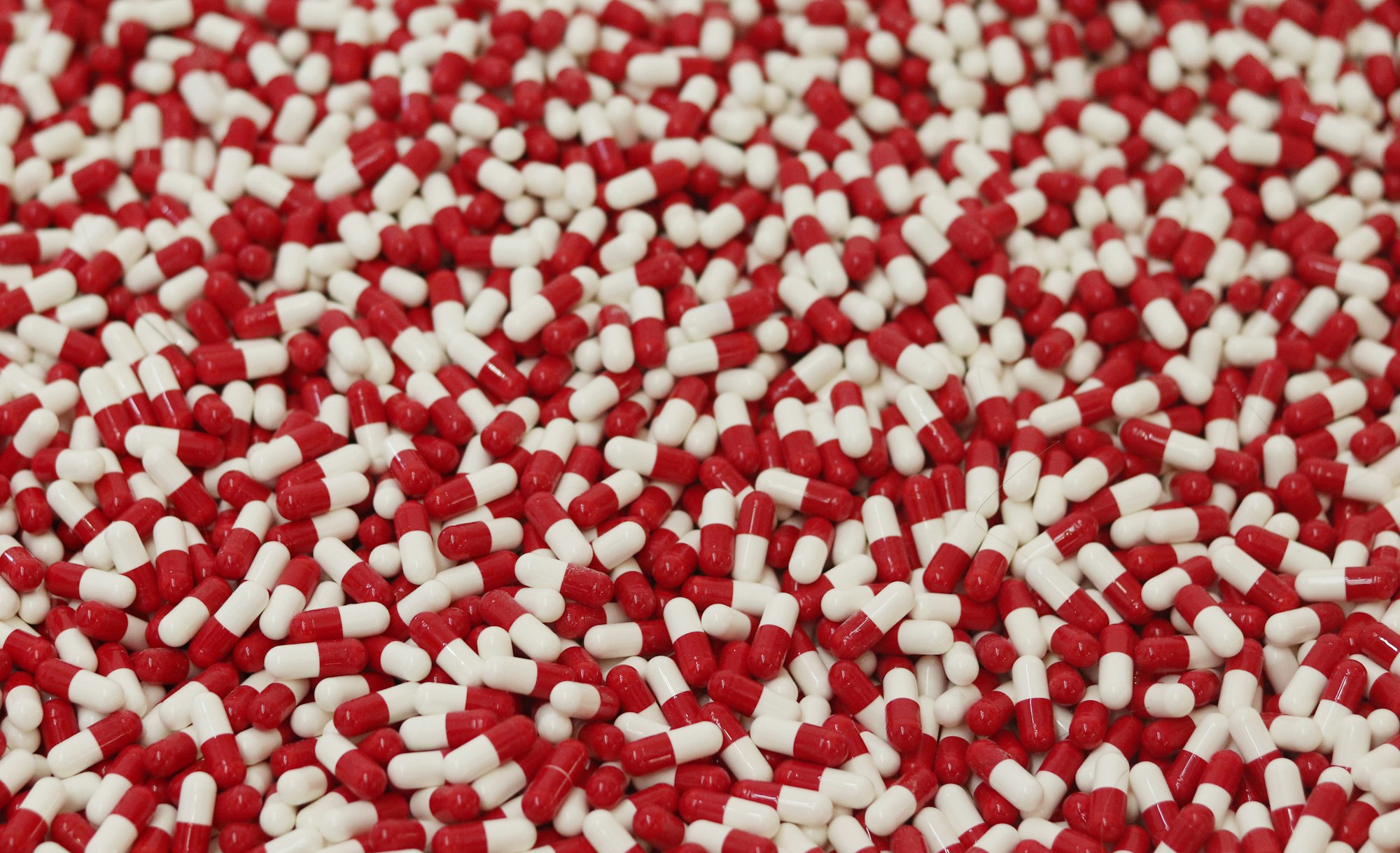Drugs

A Drug is a chemical substance used in treatment, cure, prevention, or diagnosis of diseases, or otherwise used to enhance physical or mental well being.
Key Definition: Any substance taken into the body that modifies or affects chemical reactions in the body is called as a drug
Antibiotics 💊

Antibiotics like Penicillin are chemicals that kill bacteria by destroying their cell walls. They do not hurt body cells when doing so.
They are very useful for killing bacteria unless they are used intensively (as intensive use exerts a selection pressure upon them, causing the bacteria to get resistant to them)
However, they are useless against viruses, as viruses don’t have cell walls! So next time you have a cold or flu they won’t be of any use.
Heroin

- Produced from Opium
- Opium contains the chemicals morphine and codeine used as medicine for pain relief
- Heroin is addictive and a powerful depressant.
Addictive means that it makes the person dependent on it
Depressant means that it slows down the functions of the brain and the hypothalamus, reduces pain, and slows down breathing rate.
Symptoms of Heroin Addiction:
- Person loses the ability of being a part of normal society
- Avoiding eye contact
- Avoiding distant field of vision
- Increased time spent in sleeping
- Sudden worsening of performance at school, or work including expulsion or loss of jobs
- Decreasing attention to physical appearance and hygiene
- Loss of motivation
- Apathy towards future goals
- Not able to help and support their family
- Lack of interest in hobbies and favourite activities
- Repeatedly borrowing money from loved ones, or unexplained absence of valuables
Routes of administration
- Oral
- Injection – Extremely risky, as it can give rise to HIV transmission through non-sterile needles
- Sniffing
The feeling of euphoria 🤩
The Brain 🧠 has many neurotransmitters that transfer electrical signals across synapses, from one neurone to other.
The second neurone that receives the electrical signal has receptors that fit accurately with the neurotransmitter molecules.
One group of such neurotransmitter molecules are endorphins.
Endorphins help reduce the sensation of pain and affects our mood, including hunger and thirst.
When a person takes a dose of heroin, it gets broken down to morphine in the Brain.
Morphine molecules fit precisely into some endorphin receptors, inducing the feeling of euphoria
Drawbacks of taking heroin:
- Addiction
- Lowers natural endorphin production
- Increases the risk of HIV transmission
- Increases the demand for the drug to get the same euphoric feeling
- Forces the person to take more doses with unpleasant exposure towards withdrawal symptoms
Alcohol and Alcoholism 🍷

Alcohol is a very commonly used drug as people enjoy its effect on the body. It helps them get rid of their woes and worries and boosts their ability to interact socially with people.
However, it has a many drawbacks as well:
- Alcohol lengthens reaction time: which means that it acts like a depressant and slows down the metabolic reactions in the body. This can be very risky during situations when people drink and drive.
- Alcohol can boost aggression in some people: Intake of alcohol can cause a person to succumb to committing crimes and being violent with family members.
- Enormous volumes of alcohol consumption can kill: Alcohol is like a poison; it can be life threatening if a person consumes alcohol in huge volumes, resulting in ecstasy, excitement, confusion, stupor, coma and even death!
Alcoholism
Alcoholism is a disease where a person gets addicted to alcohol. Alcoholics drink huge volumes of alcohol regularly.
Factors leading to alcoholism:
- Genes
- Personality
- Amount of stress
Effects of alcoholism
- Liver cirrhosis: Alcohol is poisonous to cells and can damage them. One such example is the liver which has the task of breaking it down. In liver cirrhosis, fibres grow inside the liver. This can be fatal!
- Brain damage: Alcohol consumption can also cause loss of memory and a lot of confusion.
- Alcohol in the body fluids draws water out of the cells through osmosis
- When this happens with the brain cells, they get irreversibly damaged.
- This damage gets worse when alcohol prohibits the secretion of a hormone that is responsible in the re- absorption of water.
- This causes too much of urine to be produced in a dilute form, resulting in low water levels in the blood.
Anabolic Steroids

Some hormones belong to group called steroids.
Examples of steroids are:
- Testosterone
- Oestrogen
- Progesterone
There are some steroid hormones that stimulate metabolic reactions in the body by the synthesis of body cells into larger molecules.
Such types of hormones are called anabolic steroids.
Let us consider the example of testosterone, which is a male reproductive hormone that is responsible for the synthesis of proteins from amino acid molecules in the muscles, so that the muscles become larger and stronger.
Anabolic steroids have been used in sport by athletes to increase their muscle size and strength. They help athletes to train harder for longer duration.
However, the usage of anabolic steroids is banned in sport as it can give any athlete unfair advantage.
Effects of anabolic steroids on health:
- Decreases immune efficiency
- Can causes damage to the liver
Tobacco smoking 🚬

The main components of tobacco are:
- Carbon monoxide
- Nicotine
- Tar
- Carbon particulates
Effects of Carbon monoxide
- Carbon monoxide is also known as the silent killer as it is a poisonous gas.
- It reduces oxygen carrying capacity of the blood.
- It gets into the alveoli of our lungs and diffuses into the red blood cells.
- In the RBC, it interferes with the haemoglobin and slowly starts to decrease the volume of oxygen each cell carries.
- This is why smokers experience breathlessness.
Effects of Nicotine
- Nicotine is addictive
- It is also a stimulant (a substance that makes the person feel more alert)
- Nicotine damages the circulatory system
- It makes the smoker’s blood vessels to get narrower
- This can cause an increase in blood pressure
- And finally, cause hypertension
- Nicotine is the substance behind Coronary Heart Disease.
Effects of Tar
- Tar contains many different chemicals such as carcinogens
- Carcinogens are substances that cause cancer
- These substances cause unusual behaviour in the cells inside respiratory passages.
- This can lead to the formation of a tumour.
- If the tumour is malignant, then it can cause cancer by breaking away from the cell and dividing uncontrollably.
- This causes lung cancer.
- Along with lung cancer, there are many other components in tar that can cause different types of cancers to the smoker.
Effects of carbon particulates
- Carbon particulates are tiny smoke particles that get into the smoker’s lungs.
- Soon they travel through respiratory passages and reach the alveoli
- The alveolar walls are extremely delicate and when these smoke particles get stuck in them, WBCs try to eradicate them by secreting chemicals.
- While the chemicals remove the smoke particles, they also damage the delicate alveolar walls.
- This leads to Chronic Obstructive Pulmonary Disease (COPD)
- It causes the surface area of the lungs to decrease and thus decreases the efficiency of obtaining oxygen.
- The person is said to have emphysema.
- A person with emphysema is forced to be less active to such an extent that they may not have the energy to even walk.
Other effects of smoking
When the chemicals present in cigarette smoke enter the circulatory system, they:
- Decrease the number of cilia.
- Decrease the efficiency of the remaining cilia.
- Increase the production of mucus in goblet cells.
- Change the direction in which the mucus flows.
- Encourage the growth of bacteria in the mucus.
- Cause mucus to get trapped inside lungs.
- Decrease the efficiency of gas exchange.
- Decrease the rate of diffusion of oxygen and carbon dioxide.
- Cause long term infections in the lungs and bronchi.
- Cause chronic bronchitis.
Smoking and Coronary Heart Disease 💔
- Smoking can cause coronary heart disease by developing a high blood pressure.
- These activities are done by a component in cigarette called nicotine.
- Nicotine damages the circulatory system.
- It also makes blood vessels narrower.
- Moreover, nicotine decreases the elasticity of arteries, disabling them to stretch and recoil much.
- Smoking also increases the probability of a blood clot being formed in the coronary artery.
This is the end of this guide. Hope you enjoyed it! Thanks for using www.igcsepro.org! We hope you will give us a chance to serve you again! Thank you!
Next Topic:


